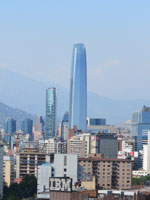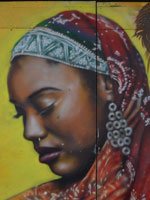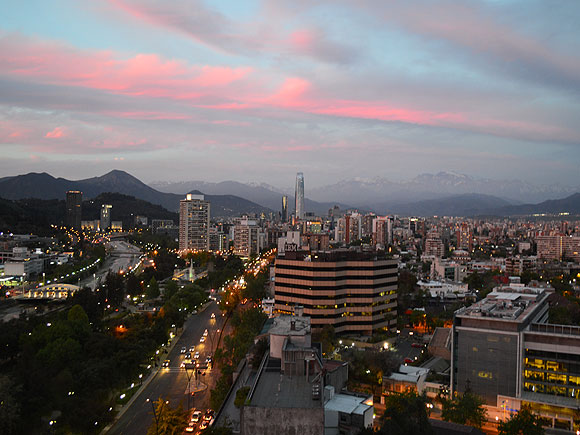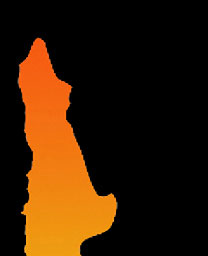

|
Discovering SantiagoUpon arriving in Santiago, I took a taxi from the airport to Providencia, a quiet neighborhood near the center of the city. I had reserved an apartment on the 21st floor of a highrise tower, with big picture windows that had a sweeping view of the city skyline and the snow-covered Andes Mountains in the background. It was an amazing sight to look out across this vast metropolis, which has been referred to as the "Latin American City of the Future" by the British Financial Times. This dynamic and cosmopolitan city of five million people is situated at the heart of Chile, along the banks of the Mapocho River halfway between the Andes and the Pacific coast. After finding my apartment and dropping off my luggage, I had the rest of the afternoon to wander around the city. I walked down the Avenida Providencia a couple of blocks to Plaza Italia, a large open gathering spot that marks the entrance to central Santiago. The urban intensity of a big city is very much in evidence here, with a diverse range of people passing by. There seemed to be some sort of zombie convention taking place, with many people splattered in fake blood and ghoulish makeup. Oblivious vendors sold paper towels and hairspray from tables set up on the sidewalk. A gay and lesbian march passed through one side of the plaza, while businessmen rushed down the stairs to the subway station. A whiff of marijuana was in the air, mixed with the aromas of food vendors and car exhaust. Stray dogs lounged on the sidewalks, impervious to the crowds of people around them. The Avenida Libertador General Bernardo O'Higgins, also known as the Alameda, is the main street that goes through the heart of Santiago. I walked down this broad boulevard to Cerro Santa Lucía, a small hill that seemed to be a fitting place to begin my explorations of the city. It was here that Santiago was founded in 1541, when Spanish explorer Pedro de Valdivia and a troop of 200 conquistadors arrived here after a long march down from Peru. Known as Huelén by the indigenous Mapuche people, Cerro Santa Lucía has gone through a number of transformations over the years. This 2,064-foot hill is the remnant of an ancient volcano, and was long used as a strategic lookout point by the Mapuche. After the Spanish camped here on the feast day of Santa Lucía, they recognized the strategic importance of the hill and began to build Santiago around it. The hill had a number of fortifications over the years, and later became a cemetary for dissidents. In 1872, the noted historian Benjamín Vicuña Mackenna was appointed mayor of Santiago and began a major renovation of Cerro Santa Lucía. The hill was transformed into a beautiful city park, spanning a series of levels that gradually ascend to the summit. Ornate stairways lead visitors up the hill, surrounded by elaborate gardens and fountains. A number of viewpoints provide panoramic vistas of the city, including a small platform at the top of the hill. From there, the geography of Santiago can be seen as if looking at the city on a map. From Cerro Santa Lucía, I continued along the Alameda and then turned down into the narrow and crowded streets of the central city. I soon came upon La Moneda, the presidential palace that is an iconic symbol of the Chilean nation. It was here that democratically elected President Salvador Allende was overthrown and murdered by the military in 1973, when tanks surrounded the palace and air force planes dropped bombs upon it. The brutal military dictatorship, led by General Augusto Pinochet and supported by U.S. business interests and the CIA, lasted until 1990, when democracy was finally restored. Today a statue of Allende stands in a prominent place in front of La Moneda. By late afternoon, it was time to run some errands, so I made my way back to Providencia. I found a supermarket and bought a few things for dinner, then took a stroll through the neighborhood. The backstreets of Providencia are beautiful, lined with large leafy trees that create a peaceful atmosphere. October is springtime in Chile, so the horsechestnut and jacaranda trees are in bloom, producing a rich scent that evokes a warm sense of well being.  Sunset over Santiago from my apartment window. I came back to my apartment after the long day of exploring the city. I made some dinner and settled in to enjoy the view of the city skyline with its Andean backdrop. I was startled to find that the large picture window slid open completely, even though I was up on the 21st floor. It felt like I was sitting outside, on a mountaintop, high above the city. I savored the Andean breezes that wafted through the window and began to prepare for the next two weeks of adventure in Chile. |
||||||||||
|
|||||||||||
 |
|||||||||||
|
© 2015 Michael Hanrahan
|
|||||||||||


